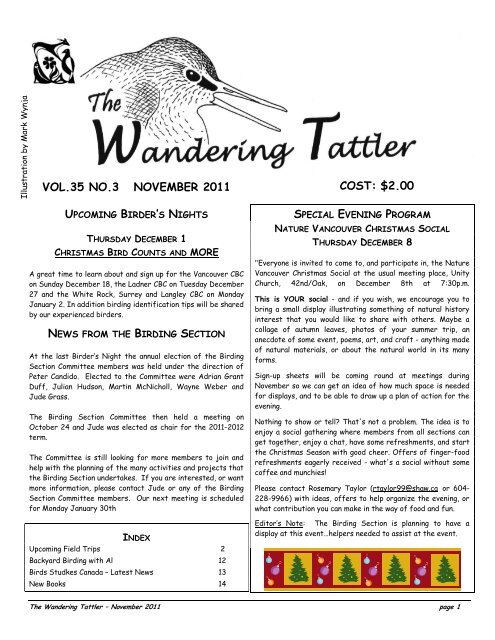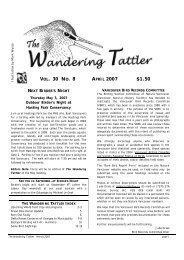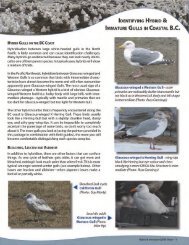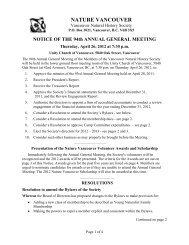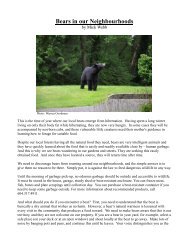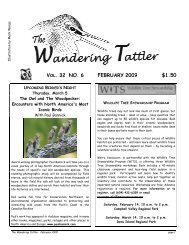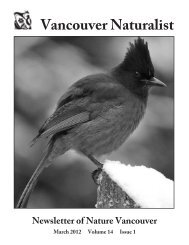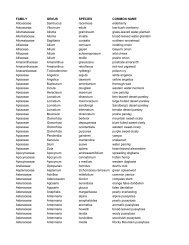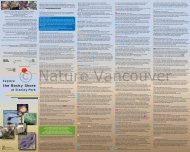Wandering Tattler - November 2011.pdf - Nature Vancouver
Wandering Tattler - November 2011.pdf - Nature Vancouver
Wandering Tattler - November 2011.pdf - Nature Vancouver
You also want an ePaper? Increase the reach of your titles
YUMPU automatically turns print PDFs into web optimized ePapers that Google loves.
Illustration by Mark WynjaVOL.35 NO.3 NOVEMBER 2011COST: $2.00UPCOMING BIRDER’S NIGHTSTHURSDAY DECEMBER 1CHRISTMAS BIRD COUNTS AND MOREA great time to learn about and sign up for the <strong>Vancouver</strong> CBCon Sunday December 18, the Ladner CBC on Tuesday December27 and the White Rock, Surrey and Langley CBC on MondayJanuary 2. In addition birding identification tips will be sharedby our experienced birders.NEWS FROM THE BIRDING SECTIONAt the last Birder’s Night the annual election of the BirdingSection Committee members was held under the direction ofPeter Candido. Elected to the Committee were Adrian GrantDuff, Julian Hudson, Martin McNicholl, Wayne Weber andJude Grass.The Birding Section Committee then held a meeting onOctober 24 and Jude was elected as chair for the 2011-2012term.The Committee is still looking for more members to join andhelp with the planning of the many activities and projects thatthe Birding Section undertakes. If you are interested, or wantmore information, please contact Jude or any of the BirdingSection Committee members. Our next meeting is scheduledfor Monday January 30thINDEXUpcoming Field Trips 2Backyard Birding with Al 12Birds Studkes Canada – Latest News 13New Books 14SPECIAL EVENING PROGRAMNATURE VANCOUVER CHRISTMAS SOCIALTHURSDAY DECEMBER 8"Everyone is invited to come to, and participate in, the <strong>Nature</strong><strong>Vancouver</strong> Christmas Social at the usual meeting place, UnityChurch, 42nd/Oak, on December 8th at 7:30p.m.This is YOUR social - and if you wish, we encourage you tobring a small display illustrating something of natural historyinterest that you would like to share with others. Maybe acollage of autumn leaves, photos of your summer trip, ananecdote of some event, poems, art, and craft - anything madeof natural materials, or about the natural world in its manyforms.Sign-up sheets will be coming round at meetings during<strong>November</strong> so we can get an idea of how much space is neededfor displays, and to be able to draw up a plan of action for theevening.Nothing to show or tell? That's not a problem. The idea is toenjoy a social gathering where members from all sections canget together, enjoy a chat, have some refreshments, and startthe Christmas Season with good cheer. Offers of finger-foodrefreshments eagerly received - what's a social without somecoffee and munchies!Please contact Rosemary Taylor (rtaylor99@shaw.ca or 604-228-9966) with ideas, offers to help organize the evening, orwhat contribution you can make in the way of food and fun.Editor’s Note: The Birding Section is planning to have adisplay at this event…helpers needed to assist at the event.The <strong>Wandering</strong> <strong>Tattler</strong> – <strong>November</strong> 2011 page 1
OTHER EVENTS FOR BIRDERSNOVEMBER … BIRDING FIELD TRIPSNOTE: There are often more birding trips listed on thewebsite http://naturevancouver.ca/ than are in the <strong>Vancouver</strong>Naturalist or WT.SATURDAY, NOVEMBER 12BIRDING IN POINT ROBERTSHalf-day birding trip to Point Roberts, Washington. We'llcarpool and visit three or four different areas on thepeninsula, looking for pelagic, open field and woodland species.Dress for the elements including waterproof footwear. Carpoolat 49th & Ash at 0730 or meet at Diefenbaker Park on FirstAvenue in Tsawwassen (north of the border) at 0800. A validpassport or Enhanced Driver's License is required to cross theborder. Bill Kinkaid 604-710-6329.SATURDAY, NOVEMBER 19BIRDING AT DEBOVILLE SLOUGH/MINNEKHADA REGIONALPARKJoin leader Larry Cowan for a half-day birding field trip toDeBoville Slough/Minnekhada RP. This area is home to manyover wintering species with waterfowl in the sloughs, pondsand river and the chance of raptors over the fields. Meet inthe parking lot adjacent to the washroom facilities at Cedar &Victoria Drs. in NE Coquitlam at 9:00 AM. We will position anappropriate number of vehicles in the parking area off QuarryRoad in Minnekhada RP for our return trip. 604-465-1402SATURDAY, DECEMBER 3DIPPER QUEST BIRDING FIELD TRIPThis half day outing is our annual search for American Dippersin the Pitt Meadows/Maple Ridge area. We have beensuccessful since 2006 finding our quarry. After locating aDipper or two we will spend the balance of the morningtravelling the Pitt Meadows/Maple Ridge area in search ofraptors, waterfowl, and other winter migrants. Meet at 9:00AM in the McDonald’s parking lot on the SW corner ofLougheed Hwy & Harris Rd. in Pitt meadows for carpooling.Your leader will be Larry Cowan 604-465-1402MAPLEWOOD FLATS CONSERVATION AREAAll levels of birders are welcome to join the Wild Bird Trust’smonthly bird survey of Maplewood Flats Conservation Area,North <strong>Vancouver</strong>. This survey is conducted on the firstSaturday of each month. Meet at 0800 in the parking lot ofthe Pacific Environment Science Centre, 2645 DollartonHighway. If the gate is closed, park adjacent to the highway.For details, please contact Janice Wilson, Bird SurveyCoordinator at 778-279 3216.On the second Saturday of each month, you’re welcome to jointhe Wild Bird Trust’s <strong>Nature</strong> Walks with Al Grass atMaplewood Flats Conservation Area. Meet at 1000 in theparking lot of the Pacific Environment Science Centre, 2645Dollarton Highway. If the gate is closed, park adjacent to thehighway Next walk October 8.HASTINGS PARK SANCTUARYMembers of the Hastings Park Conservancy’s EnvironmentalCommittee and guest naturalists lead nature walks through theSanctuary in Hastings Park. Next walk: Sat. October 26 forfurther information, contact Pat Miller at 604-294-1272.SQUAMISH ESTUARY Squamish estuary monthly bird countsare held on the first or second Sunday of each month,depending on the tide. For these half-day counts, meet at0700 (April to September) or at 0800 (October to March) atthe Howe Sound Inn and Brew Pub at the end of ClevelandAvenue in downtown Squamish. All levels of birders arewelcome to participate. The count usually lasts until 1300, atwhich time we meet back at the Brew Pub for lunch. For moreinformation, contact Judith Vetsch at 1-604-892-3340.BIRDING IN STANLEY PARK: Join naturalist CatherineAitchison for a two-hour walk in Stanley Park to identifymigratory and resident birds and learn bird-watching skills.Meet at the Lost Lagoon <strong>Nature</strong> House at 0900 on the lastSunday of every month. By donation.TERRA NOVA NATURAL AREAOn the third Saturday of each month, anyone interested inbirds is welcome to join the <strong>Nature</strong> <strong>Vancouver</strong>’s monthly birdsurvey of the Terra Nova Natural Area in Richmond. Meet inthe Terra Nova parking lot at 0800 (October-March) or 0700(April-September). For details please contact the coordinator,Eric Greenwood at 604-737-4724. The <strong>Nature</strong>Reserve is reached by driving west on Westminster Highwaypast No.1 Road, and following it through the Terra Novaresidential area.BIRD SURVEYS AT UBC FARMEvery third Sunday of each month, join in a bird survey at theUBC Farm. Meet at 8am (March to August) and 9am(September to February) at the main gate to the farm. Thefarm is located on the UBC south campus off WestbrookThe <strong>Wandering</strong> <strong>Tattler</strong> – <strong>November</strong> 2011 page 2
etween 16th and Southwest Marine Drive. The farm isnormally locked on Sunday but the group has a key. Currentlythe key is held by Sue Kay-Downs (604-569-3058). As theholder of the key, Sue is our leader, contact person and scribe.The survey is very informal, experts and beginners are allwelcome to help and learn. The gate has to be closed againonce we start so punctuality is helpful.PHOTOGRAPHY WORKSHOPSWITH RON LONG.STILL SPACES AVAILABLEVisit the websitehttp://www.birdatlas.bc.caRead the latest newsletter at:http://www.birdatlas.bc.ca/download/newsletter_summer11.pdfI need your help…I am a graduate student at Simon Fraser Universityinvestigating the nest success of Cooper’s hawks inrural and urban environments around <strong>Vancouver</strong>.PHOTOGRAPHY SEMINAR (COMPOSITION)Saturday <strong>November</strong> 12 9:30 AM – 4:00 PMBurnaby Lake Regional Park – <strong>Nature</strong> HouseFoot of Piper Avenue off Winston Street, North Side ofBurnaby LakeCost: $35.00 for members of <strong>Nature</strong> <strong>Vancouver</strong> and other BC<strong>Nature</strong> Clubs. Non-members: $45.00 Limit 15 studentsThis seminar will provide information and techniques that willsignificantly improve your photography regardless of the kindof camera you are using. The seminar is fully illustrated withhundreds of photographs to demonstrate the techniques beingdiscussed. COMPOSITION will provide many suggestions and afew simple guidelines to improve your compositions. Pleasebring your camera, an empty memory card, camera instructionbook, notebook and pen, lunch and snack. Coffee, tea and juicewill be provided.PHOTOGRAPHY SEMINAR (LIGHTING)Saturday <strong>November</strong> 129:30 AM – 4:00 PMBurnaby Lake Regional Park – <strong>Nature</strong> HouseFoot of Piper Avenue off Winston Street, North Side ofBurnaby LakeCost: $35.00 for members of <strong>Nature</strong> <strong>Vancouver</strong> and other BC<strong>Nature</strong> Clubs. Non-members: $45.00 Limit 15 studentsYour help will contribute to the broader understandingof this amazing species.If you have any informationabout a nest location ora frequently sighted Cooper’s hawk,please contact me at jbrogan@sfu.caDo you know the location of a Cooper’s hawk nest?Photography, of course, depends on light but light effects areextremely variable. How you use these effects can make thedifferent, between a stunning photograph and a boringsnapshot. This class will provide insights into the awareness,understanding and application of naturally occurring lighteffects. Please bring your camera, an empty memory card,camera instruction book, notebook and pen, lunch and snack.Coffee, tea and juice will be provided.TO REGISTER FOR ANY OR ALL OF THESE COURSESPlease phone or email Jude Grass at 604-538-8774,judegrass@shaw.ca, and then mail a cheque payable to <strong>Nature</strong><strong>Vancouver</strong> – Photography workshop (date), to 17375 27AAvenue, Surrey, BC V3S 0E9.The <strong>Wandering</strong> <strong>Tattler</strong> – <strong>November</strong> 2011 page 3
BC FIELD ORNITHOLOGISTTWO DAY FIELD TRIPS FOR MEMBERS(AND OTHERS)Fraser River Delta<strong>November</strong> 12-13, 2011See wintering raptors and vast numbers of waterbirds thatuse the delta in winter. Experience some of Canada’s bestwinter birding right on <strong>Vancouver</strong>’s doorstep. Gyrfalconanyone?How to Participate:These two day trip are BCFO led, but participants make theirown arrangements for accommodation, food and travel.Carpooling for birding will be arranged. Cost per two day eventBCFO Members $10.00 Non-members $40.00 which incl. BCFOmembership.To register contact:Leader George Clulow gclulow@shaw.ca 604 438 7639See website for more information:http://www.bcfo.ca/NOTE: There are some areas in the Burrard Inlet area thatneed volunteers as well as other areas in the Lower Mainland.These details will be handed out at the workshop. Also don’tfeel that you have to take an area – on your own – team areencouraged and to gain experience you can go out with others.LADNER CHRISTMAS BIRD COUNT 2011TUESDAY DECEMBER 27The Ladner CBC count will take place on Tuesday December 27.We are looking for birders to assist the experienced arealeaders by recording sightings, driving, or spotting. Noexperience needed. Birders should be willing to go out for theday starting at first light and go until late afternoon. The 12count areas within the count circle included South Richmond,South Delta including parts of Burns Bog, Tsawwassen & PointRoberts, Boundary Bay, Brunswick Point and Westham Islandand the Reifel Bird Sanctuary. For those that don’t want tospend the day outdoor we are also looking for feeder watcherswho will record the birds seen at their feeders. The postcount get together will start at 5pm at the Reifel BirdSanctuary where dinner will be available ($9.00 per person),and where we will do a count summary of species seen.For more info or to sign up please contactCount Coordinator Jude Grassat 604 538 8774 or judegrass@shaw.ca.BIODIVERSITY CENTREFOR WILDLIFE STUDIESANNUAL GENERAL MEETINGSATURDAY NOVEMBER 19, 20111:30PM TO 3:30PM ATOWL – ORPHANED WILDLIFE REHABILITATION SOCIETY3800 – 72 ND STREET, DELTA, B.C.Meeting in School Building near the OfficeEveryone WelcomeCome and learn about the BCFWSRefreshments will be servedAGM AGENDAIntroductionsReport on Society Business & ActivitiesElection of BoardNew BusinessFollowed by a Tour of the OWL Facilities with staffPlease RSVP to judegrass@shaw.caor phone 604-538-8774if you plan to attend the AGM. Thank you.For SaleKowa telescope, two eyepieces,tripod and pan head: $900.00TSN-4 Kowa 77mm Prominar Flourite ‘scope, straightTSNE-Z4 Kowa 20-60x zoom eyepieceTSNE-14W Kowa 30x wide angle eyepieceExcellent optics.Snap-on objective lens cover, and eye-piece caps.Sturdy aluminum Manfrotto tripod, 3-section legs, withclosed-cell foam wraps.Manfrotto pan head with quick-release.Weight: approx. 10 lbs./4.5 kgPurchased new in September 1996.Well cared-for; never dropped or damaged.Contact: Jo Ann MacKenzie 604-538-1676j.a.mackenzie@telus.net, for photos of itemsThe <strong>Wandering</strong> <strong>Tattler</strong> – <strong>November</strong> 2011 page 4
THE TRUTH ABOUT B.C. SOCKEYESALMON—WILL IT BE FOUND?Salmon spawning at Weaver Creek..By Anne Murray, September 19, 2011The future survival of the Fraser River’s wild salmon is ofoutstanding importance to British Columbia. This billion-dollarresource is priceless in terms of the ecosystem as a whole;salmon are more than just fish, they are a provincial icon.Fraser sockeye salmon had a great spawning run in 2010, with34 million returning adults, three times as many as predicted.Yet this was a huge change from the preceding years, whichsaw an unprecedented and unexplained slump from an averageof eight million spawners prior to 1992 to a mere 1.7 million in2009.What is behind this extraordinary volatility andunpredictability? Has the problem that caused the declinebeen solved, or will it return? Justice Bruce Cohen’sCommission of Inquiry into the Decline of Sockeye Salmon inthe Fraser River was instructed to find answers; the mostrecent round of evidentiary hearings, covering aquaculture, hasjust been completed.Attributing causal effects is complicated by the sockeye’s lifecycle being distributed over marine, estuarine, and riverhabitats, with a four-year abundance cycle. The commission isconsidering 26 major reports and hundreds of submissions onfactors implicated in the sockeye’s decline, including overfishing,disease, environmental changes and pollution, theimpact of fish farms located on migration routes, climatechange, and the Department of Fisheries and Oceans’ policiesand management.Any conclusion on the cause of the sockeye decline must takeinto account their sudden rebound and it is feasible that morethan one factor is involved. A disease outbreak is a highlyplausible, and complex, candidate. Pathogens may not causefatalities until an additional stress, perhaps fromenvironmental factors, such as high water temperature orpollution, tips the balance. Alternatively, rapid, virulent diseaseoutbreaks can occur among populations lacking immunity,despite an apparently healthy environment. Fungal diseases,such as chytridiomycosis in frogs and white nose syndrome inbats, have spread around the world, causing extirpations andpopulation collapse in newly exposed populations. Honey beecolonies worldwide have been struck by Colony CollapseDisorder, associated with bee paralysis viruses. In this case,environmental factors, such as an introduced Asian mite calledVarroa destructor, pesticides, and stress seem to contributeto hive collapse.If a pathogen outbreak is a cause, any role that salmonaquaculture plays in spreading the disease must be examined,given that open-net-cage facilities lie on migration paths ofFraser River sockeye. Aquaculture includes Atlantic salmon, aswell as chinook and some other species, and was begun byNorwegian investment in the early 1980s. From 1989 to ’92, adrop in the price of salmon meant consolidation into largerfacilities, with just a few owners. This was the same time thatwild fish productivity began to plummet.Pathogens with the most serious impact on sockeye includeviruses, bacteria, and parasites. Infectious hematopoieticnecrosis (IHN) virus outbreaks caused significant mortalitiesin Atlantic salmon farms near Campbell River from 1992 to2001, and have also been found in juvenile sockeye and chum infreshwater. The salmon leukemia virus is linked withplasmacytoid leukemia (infectious salmon anemia), which iscommon among seawater pen-reared chinook in Chile, Scotland,and Canada, and is also found in wild salmon. Outbreaks of thisdisease have caused death rates approaching 100 percent, andrequire total eradication of a farm’s stock to prevent spread.For long-term sustainability of all fish, regulatory governmentdepartments, and the aquaculture industry should be as openas possible about such problems. This has not been the case.The B.C. provincial government chose to block the publicrelease of fish health audit records for months, until finallysubmitting to the Cohen commission. One of these recordsshows that despite a chinook salmon farm having 96 percent ofsampled fish with symptoms of anemia, no “fish healthincident” was reported or investigated. Is such a dereliction ofduty caused by unsuitably close ties between government staffand the aquaculture companies?The federal government has also attempted to controlinformation with implications for the harmful potential ofaquaculture. In 2011, Kristina Miller, a scientist with Fisheriesand Oceans Canada, and 14 co-authors published a study in thejournal Science identifying a genomic signature (an expressionof certain genes) in wild B.C. salmon that was predictive ofwhether the fish would survive migration and spawnsuccessfully. The authors found associations between thisgenomic signature and numerous biological processes,especially those involved in response to viral infections andassociated with lymphoblastic leukemia-lymphoma. The dataled Miller et al. to hypothesize that “elevated mortality is inresponse to a virus infecting fish before river entry and thatpersists to the spawning areas”. Science is a highly prestigiousjournal and all published papers are subject to stringent peerreview. The findings were relevant and of interest to manypeople. Amazingly, the Canadian Privy Council Office preventedThe <strong>Wandering</strong> <strong>Tattler</strong> – <strong>November</strong> 2011 page 5
Miller from speaking in public or to the media about her work.She has since stated that the virus could be a major factor insockeye decline, but more research is needed. Whether therewill be funding for that work is another matter, as DFO is nowquestioning whether her lab will be able to receive externalsources of money.The possibility of a viral outbreak having an effect on wildsalmon populations is highly plausible. I believe that the vastmajority of British Columbians would like honesty and opennessin regards to this issue.Unfortunately, the close links between government and theaquaculture industry create a lack of credibility; sweepingstatements by representatives that deny any problems withfish farms or any impact on wild stocks merely increasesuspicion of a cover-up. Scientists must be free to do thenecessary research, regardless of the political and financialimplications of their findings. We need facts and clarity, notobfuscation, deception, or hidden agendas. Our wild salmon areworth it.Anne Murray is an independent writer and naturalist, and theauthor of two books on the Fraser River delta—A <strong>Nature</strong>Guide to Boundary Bay and Tracing Our Past: A Heritage Guideto Boundary Bay—both available at bookstores or fromwww.natureguidesbc.com. available at most bookstores; visitwww.natureguidesbc.comN E W S R E L E A S EMinistry of EnvironmentOctober 22, 2011PRIVATE DONATION INCREASESGRASSLANDS PROTECTED AREAPENTICTON – BC Parks’ White Lake Grasslands ProtectedArea is bigger now, thanks to an “ecological gift” from Oliverresident Denis Pelletier, Environment Minister Terry Lakeannounced today.Pelletier donated the 24.6-hectare property, valued at$475,000, to the Province in memory of his late parents whopassed away in the early 1980s. The donation of thisecologically sensitive land qualifies under Canada’s EcologicalGifts Program.The property is located in an area the Province classified asthe Ponderosa Pine Biogeoclimatic Zone. This is one of fourzones that are of provincial conservation concern. It is rare(less than one per cent of the provincial land base) and listedby B.C.’s Conservation Data Centre (CDC) as being of “specialconcern” due to high losses – 21 per cent has been convertedfor human use such as residential development and agriculture.The CDC reports 192 species potentially inhabit this site. Ofthose, several nationally listed species at risk are known toinhabit the site, based on CDC and Ministry of Environmentrecords.These include:Snakes – Western rattlesnake, gopher snake, racer.Amphibians – Great Basin spadefoot.Birds – white-headed woodpecker.The Province is installing a BC Parks 100 bench on theproperty in recognition of Pelletier’s parents.Quotes:Environment Minister Terry Lake:“The White Lake Basin has long been a priority forconservation efforts in the Okanagan. Denis Pelletier’sdonation complements the conservation values of the adjacentprotected area and serves as an excellent example of nearbylandowners working with BC Parks in helping to protectendangered ecosystems. Land donation is one of the importantaspects of stewardship the public can undertake to enhanceour parks and protected areas.”Denis Pelletier:“Contributing to public spaces like the White Lake GrasslandsProtected Area is very important for future generations.Creating, and more importantly recognizing the value of theseecologically sensitive areas is an important step towardsimproving our collective quality of life in this province.”Quick Facts:The primary role of the protected area is conservation: toprotect the very hot and dry grassland, open pine forestand alkali ponds and rock outcroppings of the SouthernOkanagan Basin Eco section.The 3,764 hectare protected area was established in 2001and covers a geographical area from lakeshore to mountaintop providing important habitat for many of BritishColumbia's endangered wildlife, plants and plantcommunities.Environment Canada’s Ecological Gifts Program offers taxbenefits to landowners.Learn More:Find out more about White Lake Grasslands Protected Area:www.env.gov.bc.ca/bcparks/explore/parkpgs/wht_lk_grass/Find out more about Canada’s Ecological Gifts Program:www.ec.gc.ca/pde-egp/default.asp?lang=EnFind out more about B.C.’s grasslands by viewing the GreatRanger Experience: South Okanagan Grasslands video:http://youtu.be/tZkd-dYbDGkFind out more about BC Parks’ park bench challenge:http://bit.ly/j9emfcThe <strong>Wandering</strong> <strong>Tattler</strong> – <strong>November</strong> 2011 page 6
POACHER CAUGHT ATBOUNDARY BAY REGIONAL PARKEditor’s Note: This is a follow up story from the EnvironmentCanada News Release that appeared in the October 2011 WT.The version below highlights the actions of Metro <strong>Vancouver</strong>Parks Staff in catching the poacher. JFGThanks to the quick work of one of our employees, a poacherhas been caught at Boundary Bay Regional Park.Richard Mills, a Parks West Area employee, was on his regularpatrol in Boundary Bay Regional Park dyke area, when he wasalerted by a local researcher and birder who suspected thattwo hunters may be shooting Dunlin birds off the dyke.Richard quickly made a call to the provincial conservationofficer who directed Delta Police to respond. The huntersthen started to return to their vehicle and Richard asked thehunters to remain on site, as requested by the conservationofficer who was still on phone communication with Richard.Richard noticed that the hunters were carrying bags of birds.Upon arrival of the police (who turned out to be a formerMetro <strong>Vancouver</strong> employee) the hunters were found to have 63Dunlins and a Great Blue Heron in their possession. Seasonalhunting with permit is allowed at Boundary Bay but under theMigratory Birds Convention Act of 1994, there is no huntingallowed of Dunlin and Great Blue Herons. It is also prohibitedto possess carcasses of these birds without lawful excuse.Hang Jian Guo was investigated and in September 2011 wasconvicted of illegal hunting. He was sentenced to pay a fine of$10,000 towards the Environment Damages Fund. The Fund,administered by Environment Canada, was created in 1995 toprovide a mechanism for directing funds received as a resultof fines, court orders and voluntary payments for the repairof the actual harm done to the environment.Above: The Dunlin is a small shore bird of the species Calidrisalpina. Under the Migratory Birds Convention Act of 1994,there is no hunting allowed of Dunlin birds.Thanks to the watchful eyes and quick action of Richard Mills,a poacher was brought to justice and served with a steep fine.Hopefully, this will be a serious deterrent to would-bepoachers in the future.PROPOSED PLAN FOR A FORESTIN WASHINGTON STATEWEAKENS PROTECTIONSFOR NORTHERN SPOTTED OWLThe U.S. Forest Service has proposed eliminating reserves inthe Okanogan-Wenatchee National Forest in WashingtonState protecting the threatened Northern Spotted Owl. Ithas also weakened management standards that could increaselogging in owl habitat. The proposal is the first for a NationalForest following completion of the Northern Spotted OwlRecovery Plan by the U.S. Fish and Wildlife Service.“This is a step in the wrong direction that will put the rapidlydeclining Spotted Owl population at even greater risk ofextinction,” said Steve Holmer, senior policy advisor forAmerican Bird Conservancy. “This proposal sets a badprecedent and is not an encouraging sign of what is to comenext from the Forest Service under the new Spotted OwlRecovery Plan.”Perhaps the most notable change in the proposed forest planwas the switch from a reserve system of areas off-limits tologging to protect owl habitat, to a reserve-less strategy. Thisidea was proposed in the draft owl recovery plan but spawnedstrong opposition from scientific societies and conservationgroups. While the proposed strategy for Okanogan-Wenatcheeindicates that a percentage of the forest will be managed forthe owl’s benefit, there is concern this protection is notguaranteed as it was under the current reserve system."The Spotted Owl Recovery Plan calls for additional habitatprotection, but this proposed plan moves in the oppositedirection and would eliminate the system of reservesdesignated to conserve the species,” said Holmer.The management standards proposed for portions of theformer habitat reserves could be potentially harmful to theNorthern Spotted Owl. The proposed plan would allow forsignificantly greater road densities (more than 15%) in at leastsix owl reserves. Greater road densities typically result inincreased logging.“Allowing greater fragmentation and road densities wouldreduce the amount of suitable owl habitat in those areas, notto mention increasing fire risks, and should not be allowed,”said Holmer.Thanks to Lynden Mager, Boundary Bay Park Operator, foralerting Internal Communications of Metro <strong>Vancouver</strong> to thisstory and to Andrew Hunt of the Iona STP for the write up.The population of the Northern Spotted Owl, listed under theEndangered Species Act in 1990, is now thought to numberfewer than 4,000 pairs, and is declining at a rate of 2.9% peryear.The <strong>Wandering</strong> <strong>Tattler</strong> – <strong>November</strong> 2011 page 7
MASSIVE BIRD KILLAT WEST VIRGINIA WIND FARMindustry assertions that just two birds per year are killed onaverage by each turbine. Data from Altamont Pass, Californiawind farms – the most studied in the nation – suggest thatover 2,000 Golden Eagles alone have been killed there.On May 23, 2003 at the Mountaineer wind farm in theAllegheny Mountains, at least 33 birds were killed. Some ofthe deaths were attributed to collisions with wind turbines andsome to collisions with a substation.October 28 2011 - With the deaths of nearly 500 birds at theLaurel Mountain wind facility earlier this month, three of thefour wind farms operating in West Virginia have nowexperienced large bird fatality events, according to AmericanBird Conservancy (ABC), the nation’s leading bird conservationorganization“Wind energy has the potential to be a green energy source,but the industry still needs to embrace simple, bird-smartprinciples that would dramatically reduce incidents across thecountry, such as those that have occurred in West Virginia,”said Kelly Fuller, ABC’s Wind Campaign Coordinator.There were three critical circumstances that tragically alignedin each of the three West Virginia events to kill these birds.Each occurred during bird migration season, during lowvisibility weather conditions, and with the addition of a deadlytriggering element – an artificial light source. Steady-burninglights have been shown to attract and disorient birds,particularly night-migrating songbirds that navigate bystarlight, and especially during nights where visibility is lowsuch as in fog or inclement weather. Circling birds collide withstructures or each other, or drop to the ground fromexhaustion.At the Laurel Mountain facility in the Allegheny Mountains,almost 500 birds were reportedly killed after lights were lefton at an electrical substation associated with the wind project.The deaths are said to have occurred not from collisions withthe wind turbines themselves, but from a combination ofcollisions with the substation and apparent exhaustion as birdscaught in the light’s glare circled in mass confusion.“The good news is that it shouldn’t be hard to make changesthat will keep these sorts of unnecessary deaths fromhappening again, but it’s disturbing that they happened at all.It has long been known that many birds navigate by the starsat night that they normally fly lower during bad weatherconditions, and that artificial light can draw them off courseand lead to fatal collision events. That’s why minimizingoutdoor lighting at wind facilities is a well-known operatingstandard. And yet lights were left on at these sites resultingin these unfortunate deaths. This reinforces the need to havemandatory federal operational standards as opposed to theoptional, voluntary guidelines that are currently underdiscussion,” Fuller said.A fourth wind farm in West Virginia, the Beech Ridge WindEnergy Project in Greenbrier County, has not experiencedlarge mortality events, likely because it is currently prohibitedby a court order from operating during night-time betweenApril 1 and <strong>November</strong> 15.“Some West Virginia conservation groups have suggested thatother wind farms in the state should shut down their windturbines at certain times and seasons to protect birds. Giventhe recurring bird-kill problems, that idea needs to beseriously considered, at least during migration season on nightswhere low visibility is predicted. A wind farm in Texas is doingjust that, so it is possible.” said Fuller.This article was written by American Bird Conservancy (ABC),a 501(c) (3) not-for-profit membership organization whosemission is to conserve native birds and their habitatsthroughout the Americas. ABC acts by safeguarding the rarestspecies, conserving and restoring habitats, and reducingthreats, while building capacity in the bird conservationmovement.Editor’s Note: Having read this article how do you nowfeel about the many wind form proposal in various partsof British Columbia, such as Pink Mountain in NortheasternBC, and some of the other sites along migrationroutes for many of our bird species?On the evening of September 24 this year at the Mount Stormfacility in the Allegheny Mountains, 59 birds and two batswere killed. Thirty of the dead birds were found near a singlewind turbine that was reported to have had internal lightingleft on overnight. This incident stands in stark contrast toThe <strong>Wandering</strong> <strong>Tattler</strong> – <strong>November</strong> 2011 page 8
BIRDS' EYE VIEW ISFAR MORE COLOURFUL THAN OUR OWNsaid. "The startling thing to realize is that although thecolours of birds look so incredibly diverse and beautiful to us,we are colour blind compared to birds."The brilliant colours of birds have inspired poets and naturelovers, but researchers at Yale University and the Universityof Cambridge say these existing hues represent only a fractionof what birds are capable of seeing.The findings based on study of the avian visual system,reported in the June 23 issue of the journal BehaviouralEcology, show that over millions of years of evolution plumagecolours went from dull to bright as birds gradually acquiredthe ability to create newer pigments and structural colours."Our clothes were pretty drab before the invention of anilinedyes, but then colour became cheap and there was an explosionin the colourful clothes we wear today," said Richard Prum,chair and the William Robertson Coe Professor in theDepartment of Ornithology, Ecology and Evolutionary Biologyand co-author of the paper. "The same type of thing seemed tohave happened with birds."Birds are well known for their stunning plumage colours, whichare created by a diverse set of pigment-based and structural(optical) mechanisms. (Credit: Courtesy of David Kjaer)BIRD SONGS CHANGEWITH THE LANDSCAPEScience Daily (June 22, 2011)Scientists have speculated for years on how birds obtainedtheir colours, but the Yale/Cambridge study was the first toask what the diversity of bird colours actually look like tobirds themselves. Ironically, the answer is that birds see manymore colours than humans can, but birds are also capable ofseeing many more colours than they have in their plumage.Birds have additional colour cones in their retina that aresensitive to ultraviolet range so they see colours that areinvisible to humans.Over time, birds have evolved a dazzling combination ofcolours that included various melanin pigments, which givehuman skin its tint, carotenoid pigments, which come fromtheir diets, and structural colours, like the blue eyes ofhumans. The study shows that the structural colours producethe lion's share of colour diversity to bird feathers, eventhough they are relatively rare among birds.Co-author Mary Caswell Stoddard of Cambridge, who beganinvestigating the avian visual system as an undergraduate atYale, would like to know why birds have not yet developed theability to produce, for example, ultraviolet yellow or redcolours in their feathers -- colours invisible to humans butvisible to the birds themselves."We don't know why plumage colours are confined to thissubset," Stoddard said. "The out of gamut colours may beimpossible to make with available mechanisms or they may bedisadvantageous.""That doesn't mean that birds' colour palette might noteventually evolve to expand into new colours," Prum said."Birds can make only about 26 to 30 percent of the coloursthey are capable of seeing but they have been working hardover millions of years to overcome these limitations," PrumWhen the going gets rough, the tough apparently sing slower.As vegetation reclaimed formerly cleared land in California,Oregon and Washington over the last 35 years, male whitecrownedsparrows have lowered their pitch and slowed downtheir singing so that their love songs would carry betterthrough heavier foliage."This is the first time that anyone has shown that bird songscan shift with rapid changes in habitat," says biologistElizabeth Derryberry who made the finding as part of herdissertation research at Duke University.She compared recordings of individual birds in 15 differentareas with some nearly forgotten recordings made at the samespots in the 1970s by a California Academy of Sciencesresearcher, and found that the musical pitch and speed of thetrill portion of the sparrows' short songs had droppedconsiderably. "I was really surprised to find that songs hadchanged in a similar way in so many different populations."She then used archival aerial photography to see how thefoliage had changed in a subset of those spots, and found thatthe one population whose song hadn't slowed down lived in anarea where the foliage hadn't changed either.The physics is clear, but the biology is a little less certain. Alower, slower song suffers less reverberation in denser foliageand will be heard more accurately. In turn, that means it ismore likely to be copied by young males who are choosing whichsong they will learn. Over generations, that should cause thesong to slow down and drop in pitch as the foliage changes.In the short term however, Derryberry doesn't know whetherthe clearer song wins better territories or mates, althoughThe <strong>Wandering</strong> <strong>Tattler</strong> – <strong>November</strong> 2011 page 9
she does know that these changes in song do affect both maleand female behaviour.The results add to a growing body of evidence that theacoustic and visual communications of animals change withtheir habitat. "Given how much the world's habitats arechanging, this is sort of an unexpected but useful factor tomonitor," Derryberry said. She's now testing the broadereffects of ecology on song evolution in birds across areas ofSouth America where habitat may be changing due todeforestation and global warming.Derryberry, who earlier discovered that female white-crownedsparrows preferred the slower new songs to the chirpy oldones, is now a researcher at Louisiana State University.White-crowned sparrow. When the going gets rough, the toughapparently sing slower. (Credit: iStockphoto/Chad Ivany)Science Daily (May 21, 2009)FIRST EVIDENCE THAT BIRDSTWEET USING GRAMMARThey may not have verbs, nouns or past participles, butbirds challenge the notion that humans alone have evolvedgrammatical rules.Bengal finches have their own versions of such rules –known as syntax – says Kentaro Abe of Kyoto University,Japan. "Songbirds have a spontaneous ability to processsyntactic structures in their songs," he says.To show a sense of syntax in the animals, Abe's teamplayed jumbled "ungrammatical" remixes of finch songs tothe birds and measured the response calls.Although many animals, including dogs, parrots and apes areknown to interpret and construct "sentences", andrecognize human words for individual objects, Abe saysthat only his finches have been shown to have a form ofgrammar in their utterances. Similar claims have been madefor whale song, however.In the wild, Bengal finches call back vigorously wheneverthey hear unfamiliar songs, usually from intruding finches.In the lab, Abe and colleague Dai Watanabe of the JapanScience and Technology Agency in Saitama exploited thesereactions to gauge whether finches could notice"ungrammatical" songs.The rulesFirst, they played finches unfamiliar songs repeatedly untilthe birds got used to them and stopped overreacting. Thenthey jumbled up syllables within each song and replayedthese versions to the birds."What we found was unexpected," says Abe. The birdsreacted to only one of the four jumbled versions, calledSEQ2, as if they noticed it violated some rule of grammar,whereas the other three remixes didn't. Almost 90 percent of the birds tested responded in this way. "Thisindicates the existence of a specific rule in the sequentialorderings of syllables in their songs, shared within thesocial community," Abe told New Scientist.In subsequent experiments Abe showed that the rules werenot innate – they had to be learned. Birds raised in isolationfailed to react to SEQ2 until they had spent two weekswith other birds. He also taught birds unnaturalgrammatical rules by habituating them to one of hisjumbled versions, then gauging their reactions to remixedversions that violated the "artificial" rules.Finally, Abe chemically destroyed an area of the braincalled the anterior nidopallium in some birds, and wasthereby able to demonstrate that it is vital for registeringfaulty grammar. In humans, a region called Broca's area isactivated when we hear ungrammatical sentences, so Abesuggests that studying the counterpart region in finchesmight throw new light on the origins of human grammar.Bird words?Constance Scharff, who works on birdsong at the FreeUniversity of Berlin, Germany, says the work is importantbecause it is often claimed that humans are the onlyspecies that uses grammar."It's an ingenious experiment showing that birds aresensitive to changes in song that are consistent withdifferent grammars," she says. "More and more, we areseeing similarities between humans and animals, and thatmakes some people uneasy."Journal reference: <strong>Nature</strong> Neuroscience,DOI: 10.1038/nn.2869Andy Coghlan26 June 2011The <strong>Wandering</strong> <strong>Tattler</strong> – <strong>November</strong> 2011 page 10
VISIT THE WEBSITE FOR MANY MORE PROGRAMSwww.birdsonthebay.caSunday <strong>November</strong> 13 10am – 2pmSeawall Waterfowl BlitzJoin Stanley Park Ecology staff and volunteers as they countevery bird that they can find along the Stanley Park seawall.This will be a great experience for people learning to identifybirds or people who want to gain practice at conducting birdsurveys. All experience levels are encouraged to attend. Bydonation to SPES . Meet: The <strong>Nature</strong> House at Lost Lagoon,Stanley Park Host: Stanley Park Ecology Society Info & Reg:604-681-7099 or conservation@stanleyparkecology.caSaturday <strong>November</strong> 19 9am-11amBird Walk at Serpentine Wildlife Management AreaDiscover the birds that make the Serpentine WildlifeManagement Area home and see the migrant travellers restingin the safety of the wetlands. Join us on a walk and get toknow our feathered friends. No experience necessary. Bringbinoculars and field guide if you have them. Wear comfortablewaterproof foot wear, dress warmly. Rain or shine. FREE.Meet: From the King George Hwy, turn west on 44 Ave (at ArtKnapp's Nursery). Proceed down the road to the parking lot onthe left. Host: Surrey Parks Info: 604-501-5158Sunday <strong>November</strong> 20 1:30 – 3:30pmFeathers, Forests and ForeshoresCurious about swan songs and Harlequin romances? Want todabble with ducks? Wade into waterfowl with naturalistMurray Lashmar as we discover the wide array of avian speciesaround Lost Lagoon., the seawall, & Beaver Lake. Cost:Members $5. Public $10.00 Meet: Stanley Park <strong>Nature</strong> Houseat Lost Lagoon Host: Stanley Park Ecology Society Info &Reg: 604-718-6522 programs@stanleyparkecology.caSunday December 11 11am – 3pmA Day for the BirdsTake a tour of the Richmond <strong>Nature</strong> Park’s wildlife garden andlearn how you can make your garden a habitat for birds. ThisFREE event takes an ecological approach and highlightsresponsible feeding practices. Adults – Walk and talk Meet:Richmond <strong>Nature</strong> Park – 11851 Westminster Hwy Host: City ofRichmond & Richmond <strong>Nature</strong> Park Society Info: 604-718-6188 www.richmond.caBirds on the Bay and Beyond is a program of Friends ofSemiahmoo Bay Society – Celebrating their 10 th AnniversaryCheck the website for upcoming course.Derek J. Matthews<strong>Vancouver</strong> Avian Research CentreMaster Bander / Bander-in-ChargeTel: (604) 218-1191 Fax: (604) 684-0308Email: Derek@birdvancouver.comWebsite: http://www.birdvancouver.com2011 CHRISTMAS BIRD COUNT DATES…..It is never too early to get the dates in your calendar (thatway you can always say “Sorry, I am busy that day” when youget invites to family events - -Again this year, due to Christmas and Boxing Day being on aweekend some of the counts are moving to week days.<strong>Vancouver</strong> CBC – SUNDAY December 18Ladner CBC – TUESDAY December 27White Rock, Surrey (and Langley) CBC – MONDAY January 2I will be adding more dates as they are finalized for the LowerMainland Counts and adding the coordinator info.The <strong>Wandering</strong> <strong>Tattler</strong> – <strong>November</strong> 2011 page 11
BACKYARD BIRDER WITH AL GRASSWELCOME THE JUNCOSJuncos, classic ground feeders, returned in good numberslocally to backyard feeders. It is true that juncos love toscratch on the ground for millet along with towhees, Goldencrownedsparrows and Varied Thrush but, juncos are also verycomfortable, feeding from perches on tube feeders loadedwith premium oil sunflower chips. Chips are 100% edible andthus the cleanest way to feed birds. Lately, juncos have alsobeen seen picking at suet cakes, perhaps on the peanut bits.Cheap suet cakes often contain seeds like millet, but the bestquality types don’t. No, the juncos are going after the best.WHO WAS ANNA?The Anna’s Hummingbird is the only hummer that stays in theNorthwest and West for the winter. How did this lovely jewel getits name? Anna’s Hummingbird was named for Princess Anna deBelle Massena. John James Audubon himself was charmed by her,but it was actually naturalist René Primevère Lesson who namedthe bird in her honour. Learn more about this dazzling jewel atCornell's AllAboutBirds. You'll find a recipe for hummingbirdnectar at SeattleAudubon.orgPhoto: Oregon Junco.Al GrassMost of our local juncos are of the “Oregon type”, but thereare always a few “slate-colored” types about. And thenthere’s the problem of trying to turn paler Oregon typesinto “pink-sided” types. Campbell, et al. 1997, Birds ofBritish Columbia, Vol. 4, Pg. 341 (UBC Press) notes: “fourspecies of the Dark-eyed Junco are known to occur in BritishColumbia”. Vanner, 2003, Encyclopaedia of North AmericanBirds, Pg. 344 (Paragon Press) comments, “the pink-sided juncosummers in the Northern Rockies”.NB: If anyone has seen a Pink-sided Junco lately at yourfeeder, please let Al know…thanks.Enjoy the juncosCheerAl Grassalgrass@shaw.caThe <strong>Wandering</strong> <strong>Tattler</strong> – <strong>November</strong> 2011 page 12
BSC ASSISTS ENVIRONMENT CANADAWITH SEABIRD-FISHERIES STUDY14 October 2011 – Bird Studies Canada's Christopher DiCorrado and Karen Barry joined Laurie Wilson and YurikoHashimoto from Environment Canada as sea bird observers tostudy the relationship between the BC Salmon Gillnet Fisheryand seabirds in waters off northern <strong>Vancouver</strong> Island.Environment Canada has been studying three areas near PortMcNeill, BC – the north side of Malcolm Island, BlackfishSound, and Johnstone Strait as well as the mouth of theSkeena River near Prince Rupert. Studies involved systematictransects in traditional fishing waters before, during, andafter the short commercial gillnet fisheries openings. Thestudy will map relative abundance, distribution, and behaviourof all birds on or flying over the water and it will compare birddata when there are no fishing fleets out at sea to bird dataduring active fishing periods. This data will provide betterunderstanding of the interaction between local seabird andfishing activities thereby helping to determine how, when, andwhere gillnet fishing may impact local seabirds and to identifypotential ways to mitigate impacts. The majority of birdsobserved during the surveys were colonial breeding speciessuch as Common Murre, Rhinoceros Auklets, Pigeon Guillemot,and Marbled Murrelets, as well as loons, grebes, and gulls. Formore information, contact Environment Canada’s Laurie Wilsonat laurie.wilson@ec.gc.ca28 October 2011 – Bird Studies Canada (BSC) is nowaccepting applications to the James L. Baillie Memorial Fundfor Bird Research and Preservation (the Baillie Fund) for the2012 grant cycle. A portion of funds raised through BSC’sannual Baillie Birdathon fundraiser are allocated to the BaillieFund to provide grants to individuals or groups for projectsthat further BSC’s mission. Since 1978, the Baillie Fund hasprovided grants totalling nearly $640,000 to 550 birdresearch and conservation projects across Canada. Inreviewing grant applications, the Baillie Fund Trustees givepriority to well-designed projects that engage the skills andenthusiasm of amateur naturalists and volunteers to help usunderstand, appreciate, and conserve Canadian birds in theirnatural environments.There are three granting programs, each with a differentapplication and review process. Applications for Regular Grantsare due by December 15, 2011; applications for Small Grantsare due by January 15, 2012; and applications for the James L.Baillie Student Award for Field Research, administered by theSociety of Canadian Ornithologists, are due by February 15,2012. For more information about the Baillie Fund grantprograms, past grants, and how to apply for a grant for yourproject, http://www.birdscanada.org/about/jlbmf/index.jspor contact the Baillie Fund Secretary at 1-866-518-0212 oracoughlan@birdscanada.orgCANADIAN MIGRATION MONITORINGNETWORK MEETS IN BC28 October 2011 – Seven Bird Studies Canada staff membersfrom our national headquarters and British Columbia officeswere among 48 participants at the recent VIIIth NationalMeeting of the Canadian Migration Monitoring Network –Réseau canadien de surveillance des migrations (CMMN-RCSM).This biennial meeting of Canada’s CMMN stations and partnerswas hosted by the Vaseux Lake Bird Observatory at Naramata,BC from October 13 to 16. Representatives of 16 memberstations and 5 associated stations participated in the meeting,along with 4 Environment Canada staff, and other CMMNsupporters. Special guest lectures were presented by DavidToews, a PhD candidate at the University of British Columbiaand Dr. Ken Otter from the University of Northern BritishColumbia. Established in 1998, CMMN membership currentlyincludes 20 bird observatories and migration research stationsfrom across Canada. The CMMN is a collaborative initiativeamong these independent member stations, BSC, and theCanadian Wildlife Service. For more information contactAudrey Heagy, aheagy@bsc-eoc.org, 1-888-448-2473 ext. 166.The <strong>Wandering</strong> <strong>Tattler</strong> – <strong>November</strong> 2011 page 13
NEW BOOKSAnser Geese, most Storm-Petrels, Sea-Eagles, long-billed Rails(Ian's comment: they look too dark to me), Rhinoceros Aukletand Pacific Puffins, Cuculus Cuckoos, Nightjars, Crows andRavens, Cistothorus Wrens, Kinglets (Ian's comment: theydidn't get the leg color on the Golden-crowned Kinglet quiteright), Phylloscopus Warblers, Palm Warbler, Waterthrushes,Chipping/Clay-colored/Brewer's Sparrows, Savannah Sparrow,White-crowned Sparrow, Emberiza Buntings, PasserinaBuntings, Brown-headed Cowbird, Rosy-Finches, CarpodacusFinches. This is a MAJOR revision of the guide!Visit NatGeoFan's YouTube channel.IAN'S RECOMMENDATION: This title is a MUST have forevery birder interested in North American birds, even if youown previous editions of this book! To enter a giveaway relatedto this book visit NatGeoBook's facebook pageDunn, Jon L. and Jonathan Alderfer. National GeographicField Guide to the Birds of North America (SixthEdition). 2011. National Geographic Society. Paperback: 574pages. Price: $27.95 U.S.SUMMARY: The National Geographic Field Guide to theBirds of North America, 6th Edition contains the most allnewmaterial since the first edition was published more than25 years ago. The 6th and latest edition includes 300 new artfigures (mostly of rarities and subspecies); unique subspeciesmaps never before seen in a field guide (detailed maps for 27species are in a separate appendix, less detailed maps for 59species are in the main text). Extensive migration informationoverlaid on species maps (colored dark yellow forSpring/Autumn migration range, green for Spring range, paleyellow for Autumn range on the maps); field-mark labels on allartwork (this feature was added to the Western/Easternguides from 2008); text updates to include (23, mostlyrarities) new species; reorganization reflecting taxonomicchanges in the bird community (AOU Checklist supplements);organization, readability, and increased page count (from 503pages in the 5th to 574 pages in the 6th) with a fresh newdesign. The Visual Index To Bird Families on the front andrear flaps is retained from the Western/Eastern guides.Major artwork changes are done for the following groups:Clement, Peter, Alan Harris and John Davis. Finches andSparrows. 1993 (reprinted 2011). Helm IdentificationGuides. Hardbound: 500 pages. (about $104.90 U.S.).SUMMARY: This is a guide to true finches (Fringillidae andEstrildidae) and (Old World) sparrows (Passeridae) illustratingall the species, many races and most sex and age variations,with almost 950 portraits. The maps accompanying theillustrations show breeding and wintering ranges for allspecies. Although the guide is not primarily intended forcagebird enthusiasts, it will also be useful for those wishing toknow more about the species encountered in captivity.IAN'S RECOMMENDATION: This is a reprint, NOT a newedition of the 1993 book. If you missed out on getting thebook the first time, here's a second chance!The <strong>Wandering</strong> <strong>Tattler</strong> – <strong>November</strong> 2011 page 14
Viewing 7,300 Bald Eagles!!Can we top that this year?OBSERVING BIRDSWOODPECKER PLAYS HIDE AND SEEKFROM HAWKToday in the back forty a Downy woodpecker was working onsome rotten Alders when a Cooper’s hawk came flashing up outof nowhere. The hawk went for the woodpecker, talons outand the Downy dodged the first pass and slide around to theside I was on which was opposite the direction the hawk hadgone. To my surprise the woodpecker disappeared and Ithought maybe the hawk had hit it and it had dropped to theground. The hawk perched not far away without anything in itstalons so I wondered where the Downy went. So did the hawkwho continually scanned the area of the tree where the birdhad been. The hawk suddenly turned its head another directionand took off after somebody else I guess. I turned back fromwatching the hawk fly away and there was the woodpecker onthe very tree it had been before! Magic? The woodpeckerlooked all around then flew away.I was curious so I went and got my bins and then climbed up anearby tree to get a better look. Directly under a branch was alarge crack in the tree. My best guess was the woodpeckerducked in there and hid. I couldn't think of any other way thebird could disappear so quickly. Thinking about it later, itseemed a risky strategy because if the hawk saw the bird go inall it had to do was wait out the woodpecker, or maybe it couldhave fished it out with an extended talon. But maybe theattention span of a hungry hawk is short enough to make itworth the chance, or maybe hawks aren't savvy enough to puttogether a missing prey and a hiding place. It still has mefilled with questions. If this happened like I think it did, arehiding places just matters of chance or do woodpeckers keepin range of such things. This hawk, or perhaps a couple, hasbeen hunting regularly in these woods recently. Do suchrecurring encounters with hawks raise a woodpecker’sawareness of escape routes? Does regular hunting in the samearea create hyper alert prey birds, thus hawks have lesssuccess and move to other locales where they can surprise newbirds easier?So many questions, so few answers. Aint nature grand?Rob SandelinNaturalistFRASER VALLEYBALD EAGLE FESTIVALNOVEMBER 19 & 20, 2011The highlight will be not just the exhibits and groundobservations of bald eagles but the Fraser River Safaritours which will be four times daily. In addition to DavidHancock's afternoon lecture both days at the Tapaderaclubhouse; he will be the guest tour guide on the FRS onthe first tour each day at 9:30 a.m.The boat is covered and heated so you won't get wet orcold. It pulls right up to the "eagle trees" and thewindows slide open for easy picture taking. Space is verylimited as the boat only seats 22.SO BOOK EARLY!!http://www.fraserriversafari.com/1-866-34-TOURSFor other events, programs, walks, etc.see the website at:http://fraservalleybaldeaglefestival.ca/The <strong>Wandering</strong> <strong>Tattler</strong> – <strong>November</strong> 2011 page 15
OWLORPHANED WILDLIFE REHABILITATION SOCIETYNATURE VANCOUVERBIRDING SECTION COMMITTEEELECTED TERM 2011-2012Jude Grass – ChairAdrian Grant DuffJulian HudsonMartin McNichollWayne Weber.VANCOUVER RARE BIRD ALERT604-737-3074Sponsored in part by:We Need Volunteers!It goes without saying that our volunteers mean everything toO.W.L. If you have a genuine interest in helping wildlife,especially birds of prey, we could use your help. Experience isnot necessary, just the willingness to learn. Volunteers must beat least 13 years of age and have received a tetanus shot inthe past 5 years. If you would like to learn about the care andhandling of these wonderful birds, we are always acceptingapplications for new volunteers for the following:Bird careRescues and pick-Ups of injured & orphaned raptorsGeneral maintenanceGardening & landscapingPaintersConstruction, building/roofing repairPublic toursSchool tours / classroom educationAnnual Open HouseFundraisers such as the Spring HootenannyGift areaOffsite displaysContact our office at 604-946-3171 between and 10:00am and3:00pm daily to schedule an interview.Meet: 3800 – 72 nd St., DeltaInfo: 604-946-3171 owlrehab@dccnet.comThe <strong>Wandering</strong> <strong>Tattler</strong> is published September to April bythe <strong>Nature</strong> <strong>Vancouver</strong> Birding Section.BE A CONTRIBUTOR TO TATTLERPlease contribute to YOUR Birding newsletter by sending in asummary of your field trip, telling about a new bird book, or anupcoming event, talk, or outing about birds, or some interestingbehaviour or action of a bird or birds you observe. Deadlinefor submissions is the 21 st of the month.Subscriptions: 1 year is $20.00 for 8 copies includes postageand handling. Please make out cheque to <strong>Nature</strong> <strong>Vancouver</strong>- <strong>Wandering</strong> <strong>Tattler</strong> and mail to the Editor.Deadline for submissions is the 21 st of the month. Please sendarticles to the Editor:Jude Grass: judegrass@shaw.ca orMail to:17375 27A Avenue, Surrey, BC V3S 0E9Phone: 604 538 8774 Fax: 604 538 8791ISSN 082 5901© <strong>Nature</strong> <strong>Vancouver</strong>(<strong>Vancouver</strong> Natural History Society)The <strong>Wandering</strong> <strong>Tattler</strong> – <strong>November</strong> 2011 page 16


